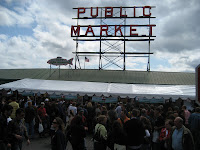 Wedged between the cookbooks in my kitchen are pages I’ve ripped out of various magazines, a paper trail of culinary aspirations that I'll probably never get around to: cooking up a batch of mozzarella cheese, brewing ginger ale, making marshmallows from scratch, stocking my cupboard with jars of homemade raspberry jam and tomato sauce. Having these recipes lying around for years could be depressing, but I actually find them comforting. Every so often I flip through the articles and recipes, never losing hope that one day I'll fill my pantry with whatever it is I’ve finally canned or pickled. But in the meantime, I’m thankful for rick’s picks. Rick is a man who began making pickles as a hobby in his Brooklyn kitchen, somehow found and attended an international pickle competition, and walked away with six ribbons and a “Best of Show” Award. Understandably, victory at the pickle competition inspired Rick to think big, and now his pickled concoctions are showing up in stores across the country. Rick’s picks are available all over New York, at the Cheese Store of Silverlake in Los Angeles, A Southern Season in Chapel Hill and numerous others states.
Wedged between the cookbooks in my kitchen are pages I’ve ripped out of various magazines, a paper trail of culinary aspirations that I'll probably never get around to: cooking up a batch of mozzarella cheese, brewing ginger ale, making marshmallows from scratch, stocking my cupboard with jars of homemade raspberry jam and tomato sauce. Having these recipes lying around for years could be depressing, but I actually find them comforting. Every so often I flip through the articles and recipes, never losing hope that one day I'll fill my pantry with whatever it is I’ve finally canned or pickled. But in the meantime, I’m thankful for rick’s picks. Rick is a man who began making pickles as a hobby in his Brooklyn kitchen, somehow found and attended an international pickle competition, and walked away with six ribbons and a “Best of Show” Award. Understandably, victory at the pickle competition inspired Rick to think big, and now his pickled concoctions are showing up in stores across the country. Rick’s picks are available all over New York, at the Cheese Store of Silverlake in Los Angeles, A Southern Season in Chapel Hill and numerous others states.Fresh, natural ingredients, unusual flavor combinations, and quirky product names set rick’s picks apart. Smokra is pickled okra with smoked paprika, Spears of Influence are cucumber spears in a cumin-scented brine, Bee n’ Beez are “turbocharged” bread and butter pickles and Phat Beets are beets pickled in a rosemary-scented brine. There are ten flavor combinations so far, and counting. I commend Rick for not only making time in his life to take up pickling as a hobby, but for going one step further and turning it into a full-fledged business. Supporting Rick's dream is simple: At your next BBQ think about how delicious some Mean Beans (green beans pickled in a cayenne-dill brine) would be next to a scoop of potato salad and how great those turbocharged pickles would be on a burger.
And by the way, if I do ever dig out that old recipe I have for brewing ginger ale, you all will be the first to know.




 milk, the fat globules are large enough that they will separate from the liquid. You may have noticed this before when you buy cream and have to shake it before pouring it so a lump of cream doesn’t drop into your coffee.
milk, the fat globules are large enough that they will separate from the liquid. You may have noticed this before when you buy cream and have to shake it before pouring it so a lump of cream doesn’t drop into your coffee. 
